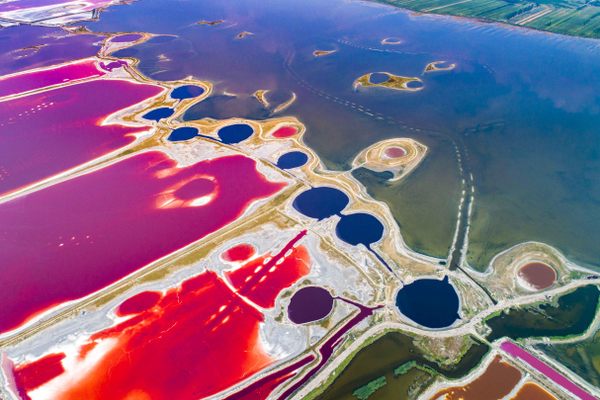How to Steal a Beach
The California Coastal Commission says that a mining operation has been illegally taking precious sand for years.

Cemex mine, Monterey Bay. (Photo: Edward Thornton)

In Northern California’s Monterey Bay, a peculiar thing happens every time there’s a storm. When wind and rain hit, a pond set back about 100 feet from the water’s edge on the beach of Marina, California fills with sand. The sand is then dredged from the pond, to the tune of roughly 200,00 cubic yards, about 8 acres of land a year, and sold.
This is the last remaining sand mine of its kind in the U.S.—namely, a sand mine that takes its material directly from the beach.
And it has enemies. For years, Edward Thornton would hike up the coastline to the site, owned by the Mexican company called Cemex. Thornton, a retired coastal engineer, has spent years fighting this operation, taking photos to build up a body of evidence, which backed up his own research, to prove to the authorities the mining was illegal and causing damage to the environment. After a six-year investigation, the California Coastal Commission told Cemex in March 2016 that it was time to end their operation—and that they had been operating without a permit since it took control of the mine over a decade ago.
“The most pristine shoreline, almost in the United States, and it has a big dollar sign on it,” says Thornton in a phone interview.

A beach along Monterey Bay. (Photo: CC BY: SA 3.0)
Sand is a lucrative commodity; the most commonly used resource after water and air, and a thriving multi-billion dollar industry. As a consequence, in some parts of the world an illegal economy has formed out of the competition for this natural resource; people have been literally killed over sand. Beaches have vanished in Indonesia and on islands in the Caribbean, sand piracy has created an ugly vision of heavy machinery dragging sand off pristine seascapes.
The demand for sand is increasing faster than the rate of natural renewal, according to a United Nations Environmental Program report in 2014. Amidst a global construction boom, sand is the key ingredient needed to produce concrete and satisfy the world’s insatiable appetite to build and expand its modern cities.

Sand mining in Kerala, India. (Photo: CC BY: SA 3.0)
Historically, the Monterey Bay area is one of the most mined stretches of coastline in the U.S. Perhaps not coincidentally, according to the U.S. Geological Survey, it has the highest rates of coastal erosion in the state of California. Records show that mining activity stretches back to the turn of the 20th century. The Lapis mine has been in operation since 1965.
The Army Corps of Engineers almost brought sand mining in Monterey Bay to an end, when in 1989 the Army shut down five mines. Officials concluded the mining there had caused extensive erosion to the shoreline.
The environmental case for shutting down the Cemex mine is a simple one: Extracting sand at such volume is eroding the coastline and ultimately making the beach slowly disappear. Experts believe the mine removes about eight acres of sand per year, causing two feet of beach loss. For the people who have studied coastal erosion, the shutdown of this mine was a long time coming.

Professor Edward Thornton. (Photo: Edward Thornton)
“There is no question in my mind the sand mining and the erosion are intimately connected,” says Gary Griggs, a professor of Earth and Planetary Sciences at University of California, Santa Cruz. Griggs first presented a report of his findings on the link between mining and beach erosion in 1985.
U.S. Congress designated the Monterey Bay area a National Marine Sanctuary in 1992 to protect one of the most diverse marine ecosystems in the country. Since 2005 a group of researchers connected to the Marine Sanctuary investigated why the shorelines in this area had so dramatically retreated. They too concluded that the Lapis mine contributes to the rapid erosion of the beaches.
Yet, the mine remains open. One reason is that the nearby city of Marina says it doesn’t have the funds to mount a legal challenge against Cemex, which is one of the wealthiest construction companies in the world. Another is that the Coastal Commission only started to investigate the legality of the mine in 2009. Before then it was unclear which governmental body actually had jurisdiction over the mine.
For its part, Cemex has refused to concede any wrongdoing. In a statement to Atlas Obscura, Cemex reiterated its position that its mining operation is legal and said it has seen no evidence to link the mine with any environmental damage in the area.
There is hope for the Monterey beaches, though. After the Coastal Commission’s investigation found that Cemex lacked the correct permits to mine, there is now something that resembles a united front in the fight to close down the mine. Local environmental groups like the Surfrider Foundation and individual campaigners in the Marina and Santa Cruz area such as Thornton continue to meet in order keep up the pressure on the Coastal Commission as it attempts to close the mine.
Within a few years, campaigners will hope that a summer storm in Monterey doesn’t have to mean that sand will be sold from its beaches.




















Follow us on Twitter to get the latest on the world's hidden wonders.
Like us on Facebook to get the latest on the world's hidden wonders.
Follow us on Twitter Like us on Facebook